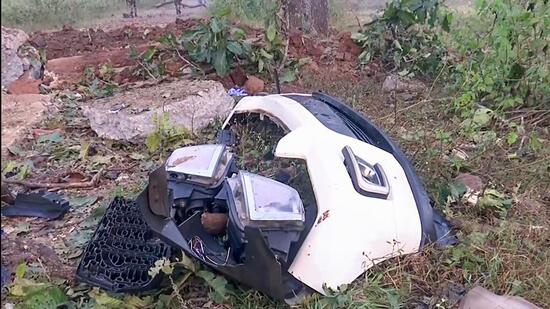Lapses in security under lens after strike by insurgents
Security lapses in Bijapur led to a deadly Maoist IED blast, killing nine. Experts suggest safer travel methods and better convoy protocols are needed.
Bijapur (Bastar): A number of security lapses, ranging from inadequate combing operations to breach of norms, may have led to the killing of nine people in an IED blast by Maoists in the Bijapur district of Chhattisgarh, officers aware of the matter said on Tuesday.

The Maoists blew up a vehicle on Monday, killing eight security personnel and a driver who were on their way back to a base in Dantewada from a joint anti-Maoist operation in the dense jungles of Abujhmad, which began on Friday. The ill-fated SUV was the eighth in a nine-vehicle convoy. The attack marked the deadliest Maoist strike in the state in two years.
According to security officers, the team should not have been travelling aboard four-wheelers, as they are more vulnerable to IED attacks carried out through the “foxhole method,” which was likely used in this incident also. Under the “foxhole mechanism,” a hole is dug to plant the IEDs beneath the ground, which is then detonated.
“Movement of security personnel by two-wheelers is safer than SUVs. The SUV blast caused more casualties...The same mistake took place in Aranpur in 2023 when 10 jawans were killed. This should have been taken into consideration,” an intelligence officer said requesting anonymity.
Also read: 4 Maoists, police constable killed in gunfight in Chhattisgarh's Abujhmad forest
The officer added that the best way to avoid foxhole-based heavy IEDs is to use two-wheelers instead of SUVs because it is difficult to detonate the explosive in the case of a lighter vehicle.
Another intelligence officer said that if there was no alternative to travelling in SUVs, then a rolling Road Opening Party (ROP) method should have been used to sanitise the road. Under this system, the first vehicle in the convoy sanitises a certain length of the stretch and stops. The second vehicle in the convoy then moves beyond the first vehicle and clears another section of the stretch. This cycle continues serially with all the vehicles in the convoy. “By this method all the SUVs move on sanitised roads, and there is very little chance of triggering an IED,” said the second intelligence officer.
On Monday, only a few personnel were deployed as part of ROP, the officer said, adding that local District Reserve Guard (DRG) personnel and spotters should have been used along with paramilitary forces for ROP duty to identify members of the frontal organisation of Maoists. According to the officer, the authorities used the same vehicles to take the personnel to the encounter site and then move them out, which was another security lapse.
A DRG constable who was part of the convoy that came under attack said eight Maoists were part of the assault. “Two Maoists carried out the IED blast while six others took strategic positions. Post-blast, the Maoists attempted to loot weapons from the forces, but the personnel in the last vehicle of the convoy retaliated, preventing the Naxals from succeeding,” said the constable requesting anonymity.
Also read: Jharkhand: 244 Maoists, 154 gangsters arrested in 2024
Another DRG officer said that the forces were caught by surprise during the encounter in Abujamad.
”Usually, Maoists take advantage of the night to flee and avoid casualties. They engage during daylight. However, in Sunday’s encounter in Abujhmad’s forests, the Naxals held their ground even at night, responding fiercely to the forces. Over a hundred Naxals opened fire from different locations. Late into the night, the Naxals used LMGs and even launched grenades. Finding themselves outgunned, the forces had to retreat,” said another DRG official.
Officers aware of the matter said that a high-level meeting of Central Committee cadres of Maoists was taking place in the area where the encounter occurred.
”Led by Ramchandran, a senior leader, the Naxals were reportedly planning a major attack. Three top Naxal leaders, each with a bounty of ₹1 crore, were present, along with other armed cadres providing advanced security. This heavy security is why the Naxals refused to retreat this time,” said another DRG official who was part of the encounter.
All Access.
One Subscription.
Get 360° coverage—from daily headlines
to 100 year archives.



HT App & Website







